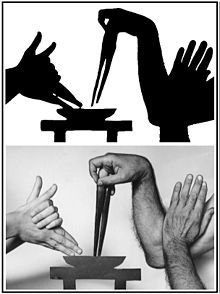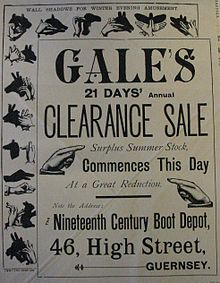- Shadowgraphy (performing art)
-
For shadow puppetry, see shadow play. For other uses, see Shadowgraphy (disambiguation).Albert Almoznino's shadow art

Performing arts Major formsMinor formsGenresDrama · Tragedy · Comedy · Tragicomedy · Romance · Satire · Epic · Lyric
Shadowgraphy or ombromanie is the art of performing a story or show using images made by hand shadows. It can be called "cinema in silhouette". Performers of the art are often called a shadowgraphist or shadowgrapher.
The art has declined since the late 19th century when electricity became available to homes because light bulbs and electric lamps do not give off good shadows and also because cinema and television were becoming a new form of entertainment. Shadows are greatly defined by candlelight and therefore hand shadows were common in earlier centuries.
The modern art of hand shadows was made popular by the French entertainer Félicien Trewey in the 19th century.[1] He popularized the art by making silhouettes of famous personalities.
Contents
Origin
Since shadows have existed since the existence of objects obstructing light, it is hard to say when the art was first used by humans for entertainment. It could have been practiced by ancient or later humans, but it probably originated in the Far East.[2] The French entertainer Félicien Trewey was interested in the art of Chinese shadow puppetry called Ombres Chinoises, which means "Chinese shadows". He popularized the art of hand shadows when he developed shadows of famous silhouettes. It then became popular in Europe in the 19th century.
Prevalence
Though the art is popular amongst different kinds of entertainers it seems prominent amongst magicians, because it was popularized by a magician who inspired many other magicians.[3] Félicien Trewey who popularized the art perfected the widely known elephant, bird, and cat hand shadows[4] and had even created some of his own, such as The Volunteer, Robinson Crusoe, The Jockey, The Rope Dancer and more.[5] In 1889 he joined with Alexander Herrmann who most likely learned it from Trewey. David Tobias Bamberg most likely learned it from Alexander who then passed it down to his son Okito (Tobias Leendert Bamberg) who then passed it down to his son Fu Manchu (David Theodore Bamberg). Other magicians who used hand shadows in their act includes David Devant, Edward Victor, and the duo Holden and Graham in which Max Holden was famous for his "Monkey in the Belfry" shadow.[3] The magician well known today in shadowgraphy is the Australian Raymond Crowe whose hand shadow act performed to the song "What a Wonderful World" by Louis Armstrong has become extremely popular, especially on YouTube.
Tools
Hands
The hands are usually exercised and different finger positions are practiced to help aid in forming the shadows.
Light source
The light source to be used should be small and bright. The best shadows come from light proceeding from the smallest possible point.[6] Albert Almoznino suggests to use a candle, a flashlight (with the lens and reflector removed) or any very small light. If a bulb is used, it should be clear. J. C. Cannell suggests in his book, Modern Conjuring For Amateurs, that the best source of light to be used is the electric arc, which Almoznino agrees to the small arc lamp, and the second best being the limelight (if used with a high-class jet). Trewey suggests unless the chalk for the limelight is cut in a triangular form, it will produce a gray border around the edge of the shadow. Cannell states another favourite amongst shadowgraphists is the use of acetylene gas (i.e. acetylene gas lamp or carbide lamp).[7]
Blank surface
Albert Almoznino suggests to use a white or light colored wall or a white sheet or table cloth for a small audience such as in a private home. If a wall is dark-colored, the sheet or table cloth can be hung against it. If you're performing for a large audience such as in an auditorium or on a stage, he suggests a screen made of muslin or other thin cloth attached to a frame. In a nightclub, hall or small theater, he suggests a nylon screen on a pliable aluminum frame. It is a screen sometimes used for TV projection and is called a rear projection screen; but the light must be stronger such as a small spotlight without the projector, lenses, or diffusers, or a motion-picture projector with the front lenses removed.[2]
Performance
The performer should sit or stand between the light source and the blank surface. The performer also has the option to perform in front of the performance surface or behind it, each with different advantages. The performer has another option to perform from the left or the right of the light source. The farther the hands are from the light, the smaller the shadows will be, while the closer the hands are to the light, the larger the shadows will be. Also, the closer you are to the blank surface, the sharper your shadows will be. Trewey suggests that the most convenient distance for the light from the hands is four feet while the hands from the performance surface should be about six feet. The performer should always watch their shadows instead of their hands.
The picture shadows should have movement to give them distinctive motions and gestures to bring them to life and give them character. Some shadows are performed with accessories attached to the hands or fingers to achieve movements or images not applicable to hands alone.
Notable shadowgraphers
- Albert Almoznino
- Amar Sen
- Bablu Mallick
- Félicien Trewey
- Henry Bursill
- Max Holden
- Philippe Beau
- Prahlad Acharya
- Raymond Crowe
- Sati Achath
Books
- Hand Shadows to be Thrown Upon the Wall by Henry Bursill (1859)
- Hand Shadows - Second Series by Henry Bursill (1860)
- Home Fun by Cecil H. Bullivant (1910)--contains a chapter on Hand Shadows
- The Art of Shadowgraphy - How it is Done by Trewey (1920)
- Hand Shadows: The Complete Art of Shadowgraphy by Lois Nikola (1921)
- The Art of Hand Shadows by Albert Almoznino (1970)
See also
References
- ^ Quick Change Artistry
- ^ a b The Art of Hand Shadows by Albert Almoznino
- ^ a b Shadowgraphy - MagicPedia
- ^ The art of shadowgraphy; how it is done
- ^ The art of shadowgraphy; how it is done
- ^ Modern Conjuring for Amateurs - Google Books
- ^ Modern Conjuring for Amateurs - Google Books
External links
- Handshadowgraphy.com
- HansDavis.com
- PhilippeBeau.com
- RaymondCrowe.com
- AmarSen.com
- The Art of Shadowgraphy: How it is Done by Trewey online book
- Modern Conjuring For Amateurs by J. C. Cannell page 234 (Hand Shadows) online book
- The Art of Hand Shadows by Albert Almoznino online book
- Hand Shadows to Be Thrown Upon The Wall by Henry Bursill
Categories:- Performing arts
- Entertainment
- Hobbies
- Storytelling
- Hand games
Wikimedia Foundation. 2010.


